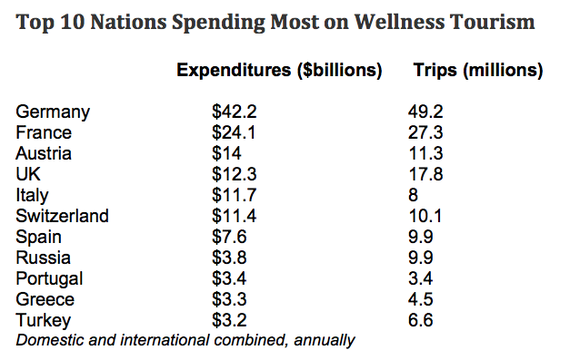“The rest of us” have long been envious of Europeans. We are constantly hearing about how much vacation time they take — and it’s true. According to Expedia’s latest “Vacation Deprivation ” report , the gap between how much time off the average European has vs. the rest of the world is striking. People in countries like France, Denmark and Spain take 26-30 days, while the average American only takes 10, and the Japanese and Koreans only take seven. That survey shows European bosses are the most supportive of employee vacation time, knowing better than the rest of the world that burned-out workers are rarely productive ones.
And research just released on wellness tourism (defined as “travel to pursue activities that maintain or enhance health and wellbeing”) reveals that not only do Europeans seem to know better than the rest of the world that travel/time off itself is essentially “healthy” — they’re also the most likely to take wellness-oriented trips:
• Europe ranks number one globally for wellness-focused trips taken (203 million/year) vs. North America trailing in second place (163 million/year).
• Europeans take nearly two in five of all such trips annually.
• Six of the top 10 nations that spend most on wellness tourism are in Europe.
Germans alone take 49 million health-focused trips yearly, representing $42 billion, this single, not-so-huge country drives nearly one in 10 of all wellness tourism “dollars” spent worldwide. And while Germany has a population roughly four times smaller than the U.S., they rank number one for international wellness travel — trumping Americans (number two), who are notoriously “passport-averse.”
It’s further confirmation that Europeans remain the most sophisticated prevention-focused travelers on Earth. They not only take frequent health-bent trips within their own countries — and hopscotching across Europe — they’re the largest market for international/outbound wellness travel.
Europeans come by this love of wellness honestly — it’s a homegrown affair. Countries like Austria, Germany, Italy and Switzerland — and all of Eastern Europe — have a centuries-old tradition of traveling for “Kur” (also known as “taking the cure”), which involves a variety of curative, therapeutic experiences like “taking” the thermal waters, massage and other hydrotherapy- and natural-based experiences.
In European countries like Denmark and Norway, the government subsidizes this kind of travel as part of routine healthcare. (Wouldn’t it be great if that caught on in the U.S.?) Offerings in Europe are more “democratized” than most regions: with more health resorts at more within-reach price-points.
So, some wisdom from Europeans for the “rest of us” — healthy travel is not an indulgence — it’s a critical part of self- and health-care.
And people continue to need more affordable/accessible destinations, so more people can benefit.
One example of the sophistication (and growth) of wellness destinations in Europe is the famed Brenner’s Park Hotel & Spa in Germany, which just opened a large medical destination spa, Villa Stéphanie, connected to Haus Julios, bringing together medical experts in everything from dermatology to cardiology. Brenner’s Park spa manager, Hans-Peter Veit, notes: “What our guests are now seeking is far more profound than in the early days of spas: they want a completely holistic, comprehensive wellness experience. Yes, beauty, but also nutrition and detox, an integrated medical-wellness approach to physical health, and training to keep their mind healthy. Given people’s incredibly hectic lives today, they increasingly seek places that specialize in helping them recover, and also give them the inspiration and education to live a longer, happier and healthier life.”
Rest of the World Plays Catch Up
So will the rest of us catch up with Europe’s understanding of the true value of healthy travel experiences that restore and rejuvenate?
The wellness research shows that is precisely what’s happening — while Europe will see a healthy 7.3 percent annual growth rate in its long-established wellness tourism market through 2017, the average global growth rate will be roughly 10 percent. And it’s developing markets (in Asia, Latin America and the Middle East/Africa) that will see the biggest uptick in both domestic and inbound wellness tourism. Countries like China, India, the Philippines and Vietnam will clock roughly 20 percent annual growth!
Also, if wellness-focused travelers to Europe have historically been most likely to hit France, Austria and Germany, what you could dub a “New Europe” is emerging: with countries like Russia, Turkey, Poland, Hungary and the Czech Republic representing five of the top six European growth-leaders for wellness travel through 2017.
Traditional health resorts and thermal facilities in eastern and central/southern Europe are now busy modernizing to broaden their international appeal: like Turkey where ancient hamams are undergoing multimillion-dollar restorations -or historic spa town(s), and recent Olympics site, Sochi, in Russia, with its many brand-new spa hotels.
So, all of us increasingly “European-like,” healthy-minded travelers will have a much bigger map of nations/destinations to explore in coming years. Europeans have blazed the healthy travel trail but increasingly the whole world is getting in on it.
source: http://www.huffingtonpost.com / Huffington Post / Home> HuffPost Travel / by Susie Ellis, Chairman & CEO, the Global Spa & Wellness Summit / April 25th, 2014


